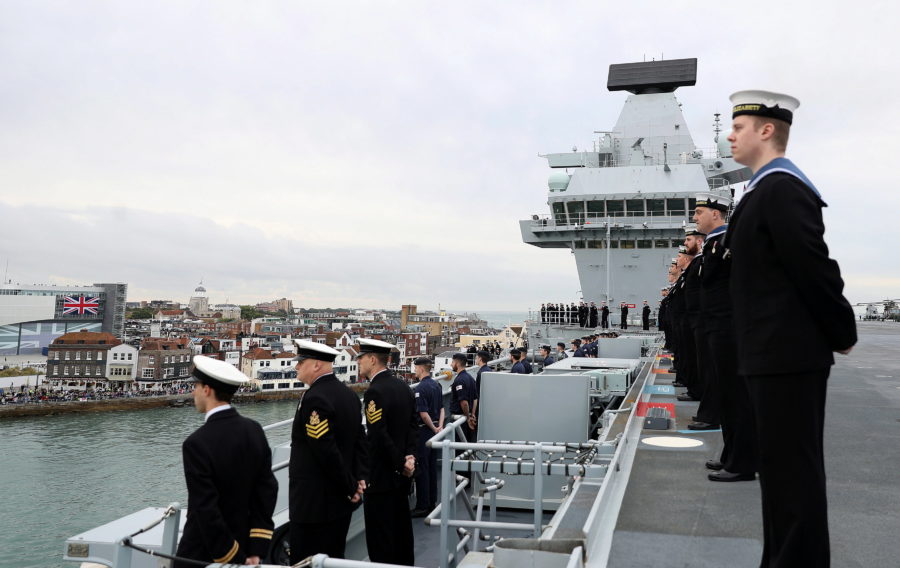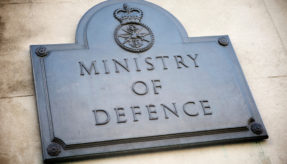
HMS Queen Elizabeth was welcomed by tens of thousands of people as the UK’s flagship aircraft carrier arrived at her new home at Her Majesty’s Naval Base Portsmouth last month. Defence features writer Matt Brown looks at the role DIO played in ensuring an ambitious programme of harbour upgrade works smoothed the way.
HMS Queen Elizabeth, the Royal Navy’s new £3 billion flagship aircraft carrier, has been described by Prime Minister Theresa May as a symbol of the UK’s position as a “great global maritime nation”.
The special relationship between Her Majesty’s Naval Base (HMNB) Portsmouth and the Royal Navy dates back to the reign of Henry VIII and was not lost on the commanding officer of HMS Queen Elizabeth, Captain Jerry Kyd.
Speaking on the vessel’s arrival into Portsmouth, he commented: “HMS Queen Elizabeth’s first entry into her home port of Portsmouth is an historic, proud and exciting occasion, not only for those of us serving in her, but also for the wider Royal Navy, the city of Portsmouth and the entire nation.
“The Royal Navy has a very special relationship with Portsmouth dating back half a millennium and both carriers, HMS Queen Elizabeth and HMS Prince of Wales, will ensure the Navy’s city remains the focal point of our great nation’s maritime power for generations to come.”
No doubt the excitement of the crowds who welcomed HMS Queen Elizabeth into port was driven by the impressive sight of the 65,000 tonne vessel making her way home for the first time, but what many of those waving flags might not have realised is the massive amount of work and investment that went into ensuring HMNB Portsmouth would be capable of berthing the new Queen Elizabeth class vessels.
The Defence Infrastructure Organisation (DIO) played a key role in achieving this goal as it invested £100 million in upgrades to the harbour.
The 276m jetty was built in the 1920s and was last upgraded almost 40 years ago. The original 1920s sections were recently replaced with 3300 tonnes of new steel work while the 1970s sections were reinforced with 2500m3 of new reinforced concrete.
Work also included the installation of a new frequency converter – vital to the powering of the ship. Worldwide, vessels operate on a 60Hz frequency; however, the UK National Grid operates at 50Hz so the electricity must be converted before it can be supplied to the ship.
The power comes to the frequency converter via 2.6 miles of cables installed between Old Portsmouth and the jetty. The converter consists of two parts, the converter itself and the motor, each weighing in at 50 tonnes. An electrical substation was also built situated on the jetty for the frequency convertor.
To allow the carriers safe passage into their new Portsmouth home, navigation lights have been installed to guide the vessels through the narrow harbour entrance. The navigation aids are positioned on top of 14 large steel tower structures that stand 30m from the seabed.
Getting the lights into position and minimising the impact upon other harbour users was no easy feat and required close collaboration between the DIO, principal contractors VolkerStevin and the Queen’s Harbour Master. The lights weigh around 22 tonnes and were lifted into position using a 350 tonne crane barge.
The navigation guides are powered by both solar panels and batteries to allow them to function regardless of weather conditions. In an effort to reduce distraction to other vessels, the lights will only be use when the carriers are either approaching or leaving their berths at Portsmouth.
On the importance of getting this process right, Philip Wise, DIO’s Principal Project Manager, said: “Portsmouth is a busy harbour for both civilian and military vessels so it was important to have these discussions to make sure the work could take place safely and with the minimum disruption to other harbour users.”
Catamarans will also be used to prevent the vessels from clashing with the jetty as they move up and down with the tide.
The approach channel, inner harbour and berth all required dredging to make them deep and wide enough to cope with the new ships. The total area dredged was around 157 hectares, which is the equivalent of 200 football pitches, and saw about 3,200,000m3 of material removed from the seabed.
During the course of the dredging, nearly 21,000 individual items were recovered that highlighted the strategic importance of the harbour during the Second World War. Among the items recovered were an aircraft engine, a German sea mine, five large bombs and a British torpedo.
The dredging process also required a strict adherence to ensure there was minimal impact on the local environment.
Garry Brimecome, DIO’s Project Manager for the dredge at Portsmouth, explained: “We took the environmental requirements of the project very seriously. The marine licence sets out stringent requirements, which take into account the local marine and coastal environment.
“We had to relocate local oyster growers and avoid restrictions on bird reserves. All this important work had to be done without impacting on the existing operations at HMNB Portsmouth.”
The importance of the infrastructure works undertaken at HMNB Portsmouth cannot be overstated. Without the infrastructure improvements, Portsmouth would not have been capable of taking the new carriers, given their much greater size to any previous Royal Navy vessel.
Geoff Robson, DIO’s Chief Operating Officer, commented: “The work on HMNB Portsmouth has been one of our most important projects. Although not one of our larger projects in terms of cost, it’s been crucial and multi-faceted.”
images © Crown Copyright
For more information, visit: www.gov.uk/government/organisations/defence-infrastructure-organisation
If you would like to join our community and read more articles like this then please click here.
DIO Her Majesty’s Naval Base Portsmouth HMNB Portsmouth HMS Queen Elizabeth Portsmouth







